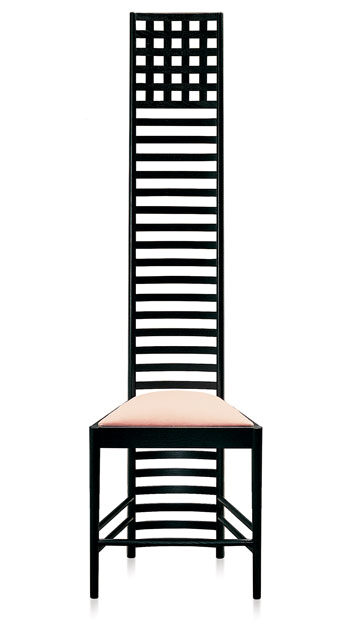Hill House Chair
Writer Ren MillerA design that’s more than the sum of its parts

The Hill House Chair by Cassina is a reproduction of an original design by Charles Rennie Mackintosh, the renowned Scottish architect, designer and artist.
The Hill House Chair is a study in contrasts. The lines are simple yet intricate. Its origin is an interpretation of Art Nouveau from the turn of the last century, but some versions look equally at home in modern settings. The design is typical of “country” chairs of the time, however, it suggests artful sophistication.
At the center of these divergences is Charles Rennie Mackintosh (1868-1928), the revolutionary and influential Scottish architect, designer and artist who designed the chair in 1903. Mackintosh attended the Glasgow School of Art and then worked for the renowned architectural firm Honeyman and Keppie, where he befriended coworker Herbert McNair. The two men, along with sisters Margaret and Frances Macdonald, realized they had similar design philosophies and began to work and exhibit together. They became known as the Glasgow Four, a major force in Art Nouveau handicrafts and architecture.
Mackintosh himself was known for his sometimes unorthodox interpretation of Art Nouveau. That interpretation didn’t gain a foothold immediately because it didn’t conform to the standards of French and Belgian Art Nouveau. However, his participation in important exhibits ranging from the Modern Decorative Arts in Turin in 1902 to the Exhibition of the Vienna Secession school in 1931 eventually won him vaunted status in the world of architecture and design.
As an architect, Mackintosh’s domestic masterpiece is considered to be Hill House, a 1903 home commissioned by book publisher Walker Blackie in Helensburgh, near Glasgow, Scotland. In fact, Mackintosh and Margaret Macdonald, by then his wife, designed almost everything for Hill House, including its furniture, textiles and the now-famous tall-backed chair named in honor of the residence.
Mackintosh designed several tall-backed chairs for large Scottish homes, primarily to help create an intimate space around a dining table or as stand-alone pieces set against the walls of halls or bedrooms. The Hill House Chair with its black finish was designed to sit — like a piece of art — against a white wall between two white wardrobes in the primary bedroom.
The chair has slender legs, double stretchers at the sides for stability and its most striking feature: an elongated narrow ladder back that reaches to the floor for added strength and rises to a grid of small squares at the top. Looking at the chair head-on, everything looks perfectly straight, but the rungs on the back are curved for comfort.
Mackintosh designed the chair of ebonized wood, similar to the lacquered wood and linear lines featured in Japanese furniture of the time, which he admired. It is also reminiscent of the bold graphics of the Vienna Secession, which he also admired. (The Vienna Secession was a then-new art movement related to Art Nouveau that had been formed by various types of artists and architects to explore non-traditional styles of artistic expression.)
The design of the Hill House Chair is all about geometry with its balance of vertical and horizontal lines and rectangular and square shapes. It was in stark contrast to the heavily upholstered, curvy furniture that had defined the Victorian era, which was just ending but retained some of its influence in the design world.
Although Mackintosh designed furniture for use in specific rooms, his designs were so successful that some went on to be manufactured and used beyond their original settings.
Today, reproductions of the Hill House Chair are available for those who want a distinctive design from the past that still looks striking. Italian manufacturer Cassina offers Hill House Chair reproductions that measure 55.5 inches high, 13.8 inches deep, 15.7 inches wide and have a seat height of 17.5 inches. They are made of black-stained ash and have a velvet seat cushion. For pricing, Cassina in New York City or Cassina.com.
